Applying Data-Driven-Based Logistic Function and Prediction-Area Plot to Map Mineral Prospectivity in the Qinling Orogenic Belt, Central China
Abstract
1. Introduction
2. Geological Setting
3. Data Set
3.1. Data Sources
3.2. Data Preprocessing
3.2.1. Geological Evidence, Main Heat Sources, and Faults
3.2.2. Geochemical Evidence
4. Methodology
4.1. Logistic Function
4.2. Prediction-Area Plot
5. Results
5.1. Data Transformation
5.2. Evaluation of Fuzzy Evidence Layers
5.3. Integration
5.4. Fuzzy Prospectivity Score Obtained Linearly (A Comparison)
5.5. To Determine the Thresholds
6. Discussion
7. Conclusions
- (1)
- Based on analysis of regional geological and geochemical characteristics, the epigenetic and ultra-epigenetic acid rock (such as the early Cretaceous granitic porphyry), the northwest-trending faults, and the accompanying secondary faults, as well as pathfinder elements (Au, As, Cu, Zn, Pb, Mo, and Cd) were identified and extracted as the main evidence layers in the search for orogenic gold.
- (2)
- The data-driven-based logistic function demonstrated an excellent ability of converting evidence values of different scales into fuzzy scores with a range of 0–1, and the relative importance of the obtained fuzzy scores was approximately in line with the original evidence values. Meanwhile, in reducing the influence of subjective preferences, the data-driven-based logistic function yielded a better prediction effect than that of traditional knowledge-driven methods.
- (3)
- Based on the analysis and application of geochemical big data, the data-driven logistic function and P–A evaluation were jointly applied to predict mineralization. The results showed that the heat source P–A plot had the highest predictive ability (81%), indicating the strong correlation between mineralization and the intermediate acid intrusive rock (vein), which is in line with the general characteristics of orogenic gold deposits.
- (4)
- The mineralization prediction map generated in the study area, in which 83% of Au occurrences were situated in 17% of the area, confirmed the joint application of data-driven-based logistic function and P–A plot to be a simple, effective, and low-cost method for mineral prospectivity mapping that could provide guidance for further research in the study area.
Author Contributions
Funding
Data Availability Statement
Acknowledgments
Conflicts of Interest
References
- Yousefi, M.; Carranza, E.J.M. Fuzzification of continuous-value spatial evidence for mineral prospectivity mapping. Comput. Geosci. 2015, 74, 97–109. [Google Scholar] [CrossRef]
- Knox-Robinso, C.M. Vectorial fuzzy logic: A novel technique for enhanced mineral prospectivity mapping, with reference to the orogenic gold mineralisation potential of the Kalgoorlie Terrane, Western Australian. Aust. J. Earth Sci. 2000, 47, 929–941. [Google Scholar] [CrossRef]
- Abedi, M.; Norouzi, G.H.; Bahroudi, A. Support vector machine for multi-classification of mineral prospectivity areas. Comput. Geosci. 2012, 46, 272–283. [Google Scholar] [CrossRef]
- Kreuzer, O.P.; Yousefi, M.; Nykänen, V. Introduction to the special issue on spatial modelling and analysis of ore-forming processes in mineral exploration targeting. Ore Geol. Rev. 2020, 119, 103391. [Google Scholar] [CrossRef]
- Yousefi, M.; Nykänen, V. Data-driven logistic-based weighting of geochemical and geological evidence layers in mineral prospectivity mapping. J. Geochem. Explor. 2016, 164, 94–106. [Google Scholar] [CrossRef]
- Behera, S.; Panigrahi, M.K.; Pradhan, A. Identification of geochemical anomaly and gold potential mapping in the Sonakhan Greenstone belt, Central India: An integrated concentration-area fractal and fuzzy AHP approach. Appl. Geochem. 2019, 107, 45–57. [Google Scholar] [CrossRef]
- Yousefi, M.; Kamkar-Rouhani, A.; Carranza, E.J.M. Application of staged factor analysis and logistic function to create a fuzzy stream sediment geochemical evidence layer for mineral prospectivity mapping. Geochem. Explor. Environ. Anal. 2014, 14, 45–58. [Google Scholar] [CrossRef]
- Carranza, E.J.M.; Hale, M. Wildcat mapping of gold potential, Baguio district, Philippines. Trans. Inst. Min. Metall. Sect. B Appl. Earth Sci. 2002, 111, 100–105. [Google Scholar] [CrossRef]
- Carranza, E.J.M. Improved wildcat modeling of mineral prospectivity. Resour. Geol. 2010, 60, 129–149. [Google Scholar] [CrossRef]
- Yousefi, M.; Carranza, E.J.M. Data-driven index overlay and boolean logic mineral prospectivity modeling in greenfields exploration. Nat. Resour. Res. 2016, 25, 3–18. [Google Scholar] [CrossRef]
- Du, X.; Zhou, K.; Cui, Y.; Wang, J.; Zhang, N.; Sun, W. Analytical hierarchy process (AHP) and prediction-area (P-A) plot for mineral prospectivity mapping: A case study from the Dananhu metallogenic belt, Xinjiang, NW China. Arab. J. Geosci. 2016, 9, 298. [Google Scholar] [CrossRef]
- Zadeh, L.A. Fuzzy sets. IEEE Information and Control. 1965, 8, 338–353. [Google Scholar] [CrossRef]
- Moon, W.M.; Ping, A.N. Integration of geological, geophysical, and remote sensing data using fuzzy set theory. Geoinformatics FCE CTU 1991, 2, 171–176. [Google Scholar] [CrossRef]
- Cheng, Q.; Agterberg, F.P. Fuzzy weights of evidence and its application in mineral potential mapping. Nat. Resour. Res. 1999, 8, 27–35. [Google Scholar] [CrossRef]
- Carranza, E.J.M.; Hale, M. Geologically-constrained fuzzy mapping of gold mineralization potential, Baguio district, Philippines. Nat. Resour. Res. 2001, 10, 125–136. [Google Scholar] [CrossRef]
- Luo, X.; Dimitrakopoulos, R. Data-driven fuzzy analysis in quantitative mineral resource assessment. Comput. Geosci. 2003, 29, 3–13. [Google Scholar] [CrossRef]
- Nykänen, V.; Groves, D.I.; Ojala, V.J.; Eilu, P.; Gardoll, S.J. Reconnaissancescale conceptual fuzzy-logic prospectivity modeling for iron oxide copper–gold de-posits in the northern Fennoscandian Shield, Finland. Aust. J. Earth Sci. 2008, 55, 25–38. [Google Scholar] [CrossRef]
- Lusty, P.A.J.; Scheib, C.; Gunn, A.G.; Walker, A.S.D. Reconnaissance-scale prospectivity analysis for gold mineralization in the Southern Uplands-Down-Longford Terrane, NorthernIreland. Nat. Resour. Res. 2012, 21, 359–382. [Google Scholar] [CrossRef]
- Abedi, M.; Norouzi, G.H.; Fathianpour, N. Fuzzy outranking approach: A knowledge-driven method for mineral prospectivity mapping. Int. J. Appl. Earth Obs. Geoinf. 2013, 21, 556–567. [Google Scholar] [CrossRef]
- Ford, A.; Miller, J.M.; Mol, A.G. A comparative analysis of weights of evidence, evidential belief functions, and fuzzy logic for mineral potential mapping using incomplete data at the scale of investigation. Nat. Resour. Res. 2016, 25, 19–33. [Google Scholar] [CrossRef]
- Porwal, A.; Carranza, E.J.M.; Hale, M. Artificial neural networks for mineral potential mapping: A case study from Aravalli Province, Western India. Nat. Resour. Res. 2003, 12, 155–171. [Google Scholar] [CrossRef]
- Carranza, E.J.M. Geochemical anomaly and mineral prospectivity mapping in GIS. In Handbook of Exploration and Environmental Geochemistry; Elsevier: Amsterdam, The Netherlands, 2008; Volume 11, p. 351. [Google Scholar]
- Carranza, E.J.M.; Hale, M.; Faassen, C. Selection of coherent deposit-type locations and their application in data-driven mineral prospectivity mapping. Ore Geol. Rev. 2008, 33, 536–558. [Google Scholar] [CrossRef]
- Zuo, R. Regional exploration targeting model for Gangdese porphyry copper deposits. Resour. Geol. 2011, 61, 296–303. [Google Scholar] [CrossRef]
- Liu, Y.; Cheng, Q.; Xia, Q.; Wang, X. Mineral potential mapping for tungsten polymetallic deposits in the Nanling metallogenic belt, South China. J. Earth Sci. 2014, 25, 689–700. [Google Scholar] [CrossRef]
- Liu, Y.; Cheng, Q.; Xia, Q.; Wang, X. The use of evidential belief functions for mineral potential mapping in the Nanling belt, South China. Front. Earth Sci. 2015, 9, 342–354. [Google Scholar] [CrossRef]
- Yousefi, M.; Kreuzer, O.P.; Nykänen, V.; Hronsky, J.M.A. Exploration information systems – A proposal for the future use of GIS in mineral exploration targeting. Ore Geol. Rev. 2019, 111, 103005. [Google Scholar] [CrossRef]
- Billa, M.; Cassard, D.; Lips, A.L.W.; Bouchot, V.; Touliere, B.; Stein, G.; Guillou-Frottier, L. Predicting gold-rich epithermal and porphyry systems in the central Andes with a continental-scale metallogenic GIS. Ore Geol. Rev. 2004, 25, 39–67. [Google Scholar] [CrossRef]
- Chung, C.F.; Fabbri, A.G. The representation of geoscience information for data integration. Nonrenewable Resour. 1993, 2, 122–139. [Google Scholar] [CrossRef]
- Porwal, A.; Carranza, E.J.M.; Hale, M. A hybrid neuro-fuzzy model for mineral potential mapping. Math. Geol. 2004, 36, 803–826. [Google Scholar] [CrossRef]
- Porwal, A.; Carranza, E.J.M.; Hale, M. A hybrid fuzzy weights-of-evidence model for mineral potential mapping. Nat. Resour. Res. 2006, 15, 1–14. [Google Scholar] [CrossRef]
- Roy, R.; Cassard, D.; Cobbold, P.R.; Rossello, E.A.; Bailly, M.; Lips, A.L.W. Predictive mapping for copper–gold magmatic-hydrothermal systems in NW Argentina: Use of a regional-scale GIS, application of an expert-guided data-driven approach, and comparison with results from a continental-scale GIS. Ore Geol. Rev. 2006, 29, 260–286. [Google Scholar] [CrossRef]
- Carranza, E.J.M.; Ruitenbeek, F.J.A.V.; Hecker, C.; Meijde, M.V.; Meer, F.D.V. Knowledge-guided data-driven evidential belief modeling of mineral prospectivity in Cabo de Gata, SE Spain. Int. J. Appl. Earth Obs. Geoinf. 2008, 10, 374–387. [Google Scholar] [CrossRef]
- Cassard, D.; Billa, M.; Lambert, A.; Picot, J.C.; Husson, Y.; Lasserre, J.L.; Delor, C. Gold predictivity mapping in French Guiana using an expert-guided data-driven approach based on a regional-scale GIS. Ore Geol. Rev. 2008, 34, 471–500. [Google Scholar] [CrossRef]
- Luo, J. Statistical mineral prediction without defining a training area. Math. Geol. 1990, 22, 253–260. [Google Scholar] [CrossRef]
- Yousefi, M.; Kamkar-Rouhani, A.; Carranza, E.J.M. Geochemical mineralization probability index (GMPI): A new approach to generate enhanced stream sediment geochemical evidential map for increasing probability of success in mineral potential mapping. J. Geochem. Explor. 2012, 115, 24–35. [Google Scholar] [CrossRef]
- Yousefi, M.; Carranza, E.J.M.; Kamkar-Rouhani, A. Weighted drainage catchment basin mapping of stream sediment geochemical anomalies for mineral potential mapping. J. Geochem. Explor. 2013, 128, 88–96. [Google Scholar] [CrossRef]
- Liu, Y.; Zhu, L.; Zhou, Y. Application of Convolutional Neural Network in prospecting prediction of ore deposits: Taking the Zhaojikou Pb-Zn ore deposit in Anhui Province as a case. Acta Petrol. Sin. 2018, 34, 3217–3224. [Google Scholar]
- Zuo, R.; Xu, Y. Graph Deep Learning Model for Mapping Mineral Prospectivity. Math. Geosci. 2022. [Google Scholar] [CrossRef]
- Zhou, Y.; Chen, S.; Zhang, Q.; Xiao, F.; Wang, S.; Liu, Y.; Jiao, S. Advances and prospects of big data and mathematical geoscience. Acta Petrol. Sin. 2018, 34, 255–263. [Google Scholar]
- Meng, Q.; Zhang, G. Geologic framework and tectonic evolution of the Qinling orogeny, Central China. Tectonophysics 2000, 323, 183–196. [Google Scholar] [CrossRef]
- Bureau of Geology and Mineral Resources of Henan Province. Regional Geology Records of Henan Province; Geological Press: Beijing, China, 1989; (In Chinese with English abstract).
- Kerrich, R.; Goldfarb, R.; Groves Garwin, S.; Jia, Y. The characteristics, origins, and geodynamic settings of supergiant gold metallogenic provinces. Sci. China Ser. D Earth Sci. 2000, 43, 1–68. [Google Scholar] [CrossRef]
- Kerrich, R.; Wyman, D. Geodynamic setting of mesothermal gold deposits: An association with accretionary tectonic regimes. Geology 1990, 18, 882–885. [Google Scholar] [CrossRef]
- Groves, D.I.; Goldfarb, R.J.; Gebre-Mariam, M.; Hagemann, S.G.; Robert, F. Orogenic gold deposits: A proposed classification in the context of their crustal distribution and relationship to other gold deposit types. Ore Geol. Revs 1998, 13, 7–27. [Google Scholar] [CrossRef]
- Groves, D.I.; Goldfarb, R.J.; Knox-Robinson, C.M.; Ojala, J.; Gardoll, S.; Yun, G.Y.; Holyland, P. Late-kinematic timing of orogenic gold deposits and significance for computer-based exploration techniques with emphasis on the Yilgarn Block, Western Australia. Ore Geol. Rev. 2000, 17, 1–38. [Google Scholar] [CrossRef]
- Craw, D.; Begbie, M.; MacKenzie, D. Structural controls on Tertiary orogenic gold mineralization during initiation of a mountain belt, New Zealand. Miner. Depos. 2006, 41, 645–659. [Google Scholar] [CrossRef]
- Mao, J.; Goldfarb, R.J.; Zhang, Z.; Xu, W.; Qiu, Y.; Deng, J. Gold deposits in the Xiaoqinling–Xiong’ershan region, Qinling Mountains, central China. Miner. Depos. 2002, 37, 306–325. [Google Scholar] [CrossRef]
- Chen, Y.; Pirajno, F.; Qi, J. The Shanggong gold deposit, Eastern Qinling Orogen, China: Isotope geochemistry and implications for ore genesis. J. Asian Earth Sci. 2008, 33, 252–266. [Google Scholar] [CrossRef]
- Bai, H.; Cao, Y.; Zhang, H.; Zhang, C.; Hou, S.; Wang, W. Combining fuzzy analytic hierarchy process with concentration–area fractal for mineral prospectivity mapping: A case study involving Qinling orogenic belt in central China. Appl. Geochem. 2021, 126, 104894. [Google Scholar] [CrossRef]
- DZ/T 0011-2015; Specification of Geochemical Reconnaissance Survey(1:50,000). China Geological Survey Nanjing Geological Survey Center: Nanjing, China, 2015. (In Chinese)
- DZ01304-2006; The Specification of Testing Quality Management for Geological Laboratories. Ministry of Land and Resources: Beijing, China, 2006. (In Chinese)
- Hengl, T. Finding the right pixel size. Comput. Geosci. 2006, 32, 1283–1298. [Google Scholar] [CrossRef]
- Bishop, C.M. Pattern Recognition and Machine Learning; Springer Science Business Media, LLC: New York, NY, USA, 2006. [Google Scholar]
- Pirajno, F. Intracontinental strike-slip faults, associated magmatism, mineral systems and mantle dynamics: Examples from NW China and Altay-Sayan (Siberia). J. Geodyn. 2010, 50, 325–346. [Google Scholar] [CrossRef]
- Yousefi, M.; Carranza, E.J.M. Prediction–area (P–A) plot and C–A fractal analysis to classify and evaluate evidential maps for mineral prospectivity modeling. Comput. Geosci. 2015, 79, 69–81. [Google Scholar] [CrossRef]
- Herbert, S.; Woldai, T.; Carranza, E.J.M.; Ruitenbeek, F.J.A.V. Predictive mapping of prospectivity for orogenic gold in Uganda. J. Afr. Earth Sci. 2014, 99, 666–693. [Google Scholar] [CrossRef]
- Carranza, E.J.M.; Laborte, A.G. Random forest predictive modeling of mineral prospectivity with small number of prospects and data with missing values in Abra (Philippines). Comput. Geosci. 2015, 74, 60–70. [Google Scholar] [CrossRef]
- Meng, Q.; Liu, Z.; Borders, B.E. Assessment of regression kriging for spatial interpolation – Comparisons of seven GIS interpolation methods. Cartogr. Geogr. Inf. Sci. 2013, 40, 28–39. [Google Scholar] [CrossRef]
- Bishop, T.F.A.; Lark, R.M. The geostatistical analysis of experiments at the landscape-scale. Geoderma 2006, 133, 87–106. [Google Scholar] [CrossRef]
- Bonham-carter, G.F. Geographic Information Systems for Geoscientists: Modelling with GIS. Computer Methods. In The Geosciences, 13th ed.; Pergamon Press: New York, NY, USA, 1995. [Google Scholar]
- Mandelbrot, B.B. Statistics of Natural Resources and the Law of Pareto; I.B.M. Research Note NC-146; Watson Research Center: New York, NY, USA, 1962; p. 131. [Google Scholar]
- Mandelbrot, B.B. The Fractal Geometry of Nature; W.H. Freeman and Company: New York, NY, USA, 1983; p. 468. [Google Scholar]
- Mandelbrot, B.B. Self-affine fractals and fractal dimension. Phys. Scr. 1985, 32, 257–260. [Google Scholar] [CrossRef]
- Carlson, C.A. Spatial distribution of ore deposits. Geology 1991, 19, 111–114. [Google Scholar] [CrossRef]
- Cheng, Q.; Agterberg, F.P.; Ballantyneb, S.B. The separation of geochemical anomalies from background by fractal methods. J. Geochem. Explor. C 1994, 51, 109–130. [Google Scholar] [CrossRef]
- Cheng, Q.; Agterberg, F.P.; Bonham-Carter, G.F. Fractal pattern integration for mineral potential estimation. Nonrenewable Resour. 1996, 5, 117–130. [Google Scholar] [CrossRef]
- Xiang, Z.; Gu, X.; Wang, E.; Wang, X.; Zhang, Y.; Wang, Y. Delineation of deep prospecting targets by combining factor and fractal analysis in the Kekeshala skarn Cu deposit, NW China. J. Geochem. Explor. 2019, 198, 71–81. [Google Scholar] [CrossRef]
- Hodkiewicz, P.F.; Weinberg, R.F.; Gardoll, S.J.; Groves, D.I. Complexity gradients in the Yilgarn Craton: Fundamental controls on crustal-scale fluid flow and formation of world-class orogenic-gold deposits. Aust. J. Earth Sci. 2005, 52, 831–841. [Google Scholar] [CrossRef]
- Ford, A.; Blenkinsop, T.G. Combining fractal analysis of mineral deposit clustering with weights of evidence to evaluate patterns of mineralization: Application to copper deposits of the Mount Isa Inlier, NW Queensland, Australia. Ore Geol. Rev. 2008, 33, 435–450. [Google Scholar] [CrossRef]
- Ghasemzadeh, S.; Maghsoudi, A.; Yousefi, M.; Mihalasky, M.J. Stream sediment geochemical data analysis for district-scale mineral exploration targeting: Measuring the performance of the spatial U-statistic and C-A fractal modeling. Ore Geol. Rev. 2019, 113, 103–115. [Google Scholar] [CrossRef]
- Chen, D.; Wei, J.; Wang, W.; Shi, W.; Li, H.; Zhan, X. Comparison of Methods for Determining the Thresholds of Geochemical Anomalies and the Prospecting Direction-A Case of Gold Deposits in the Gouli Exploration Area, Qinghai Province. Mineral 2019, 9, 368. [Google Scholar] [CrossRef]
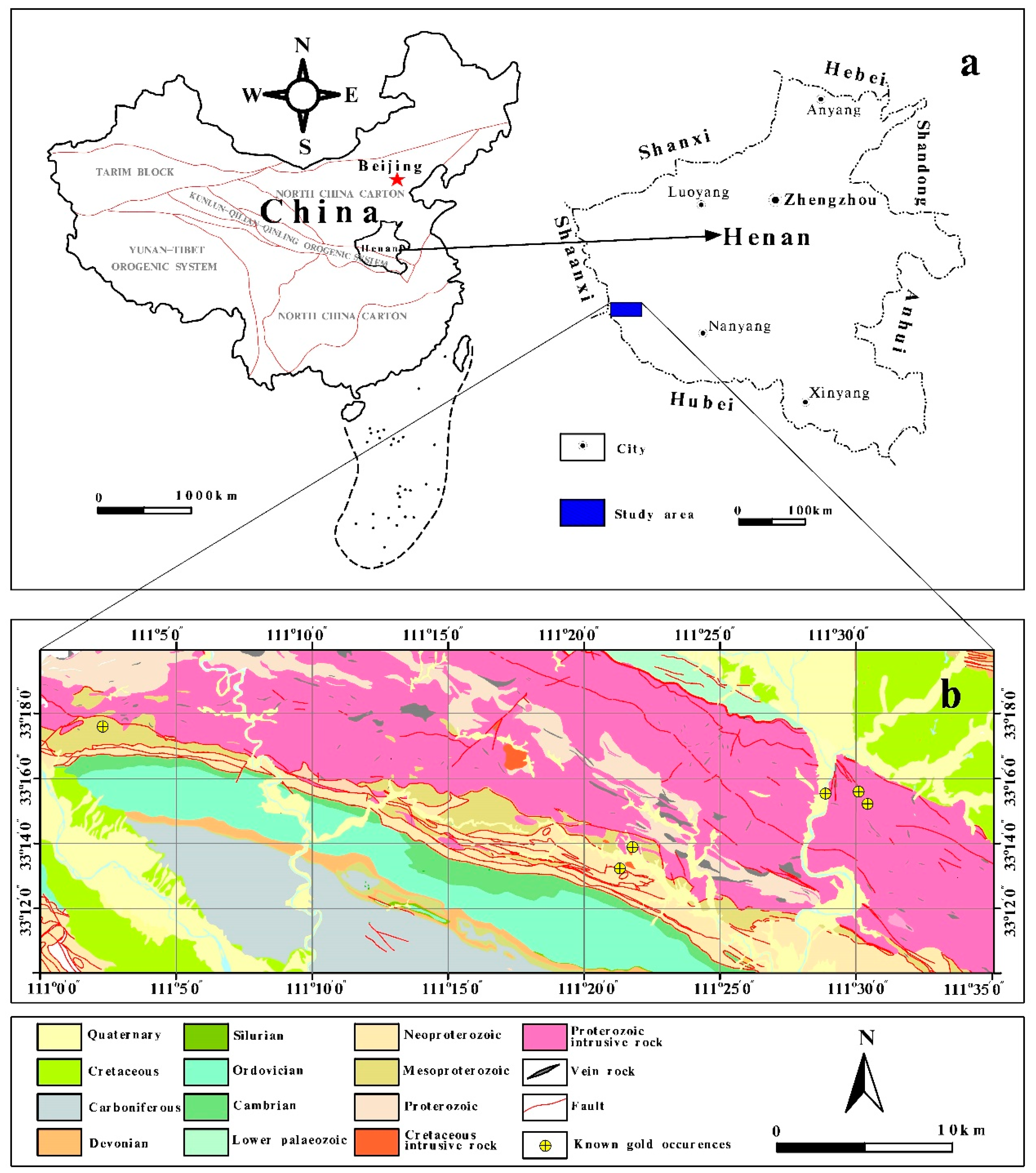
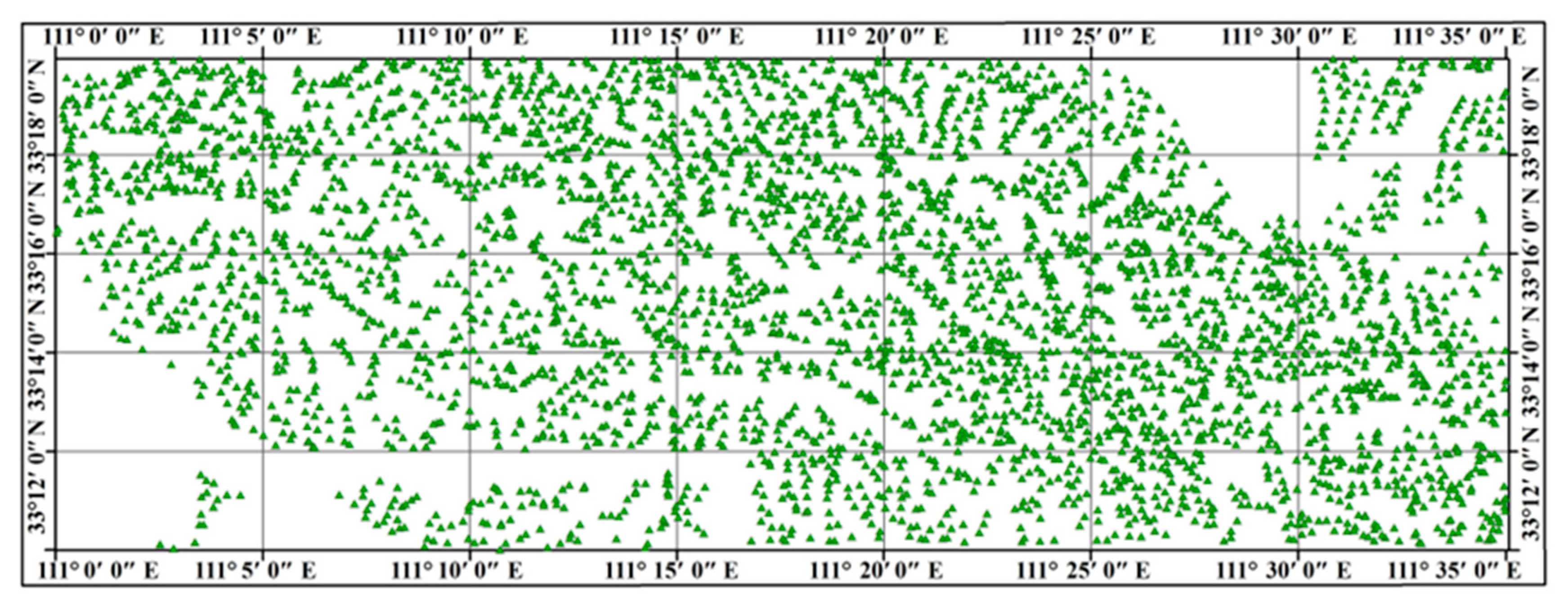

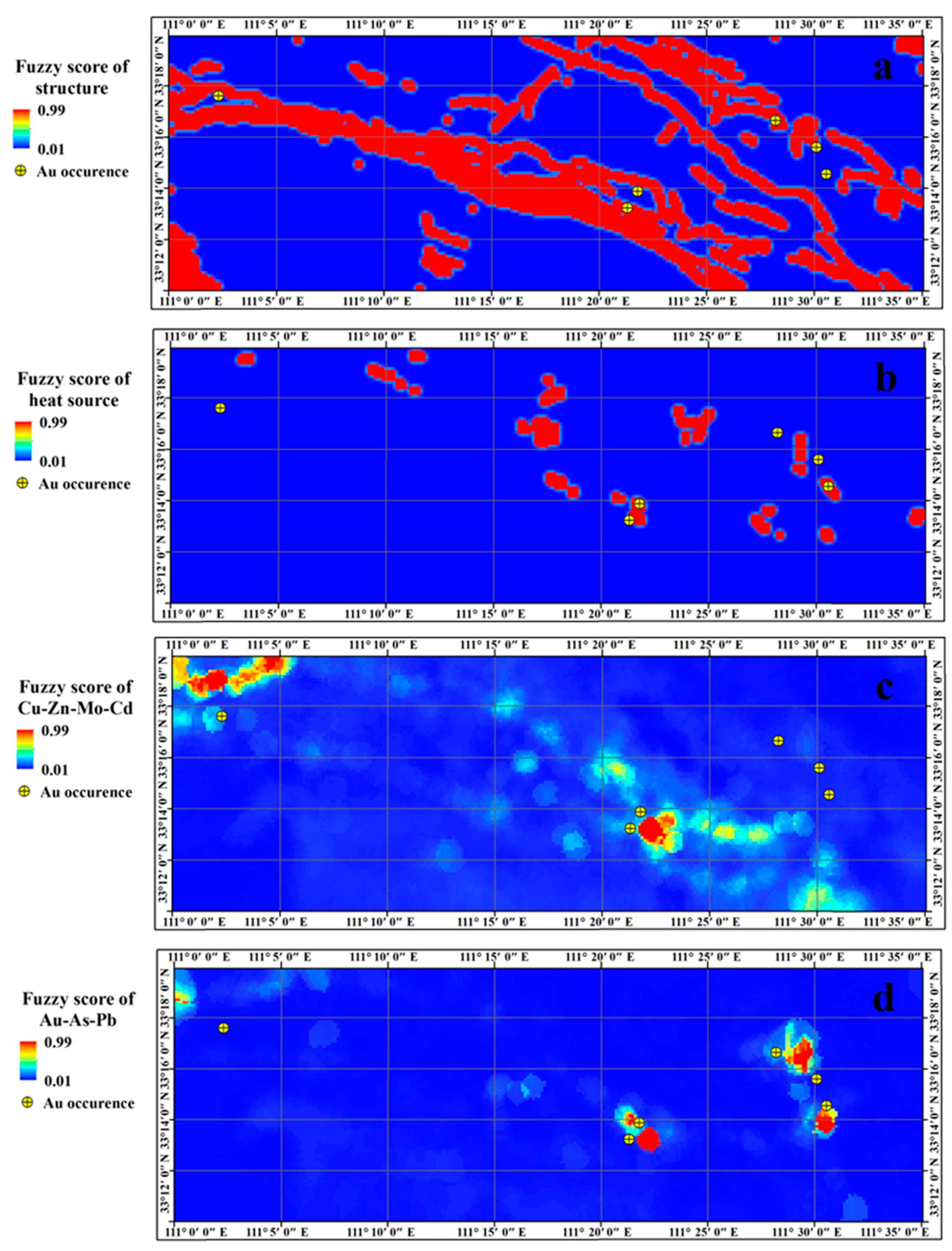
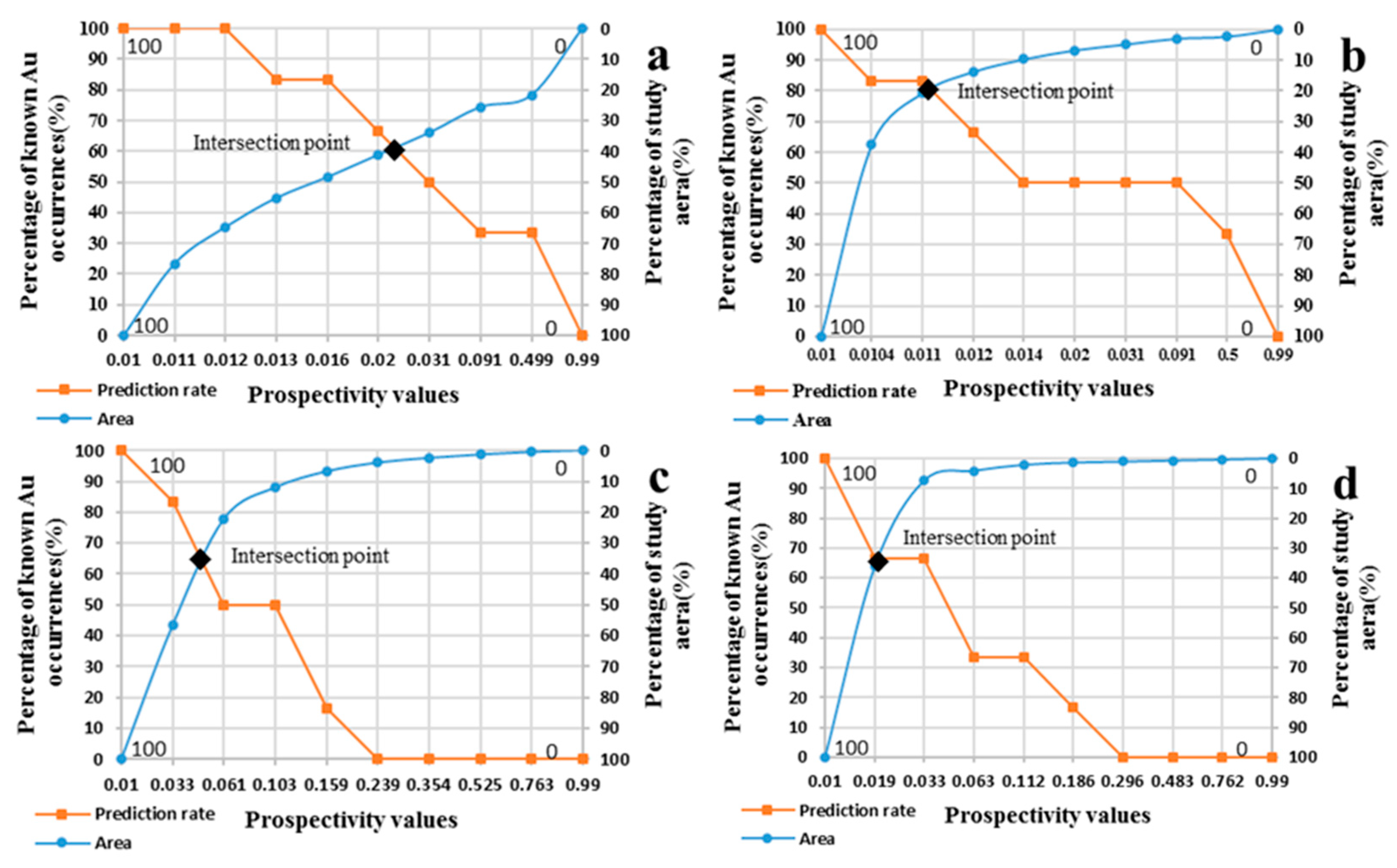
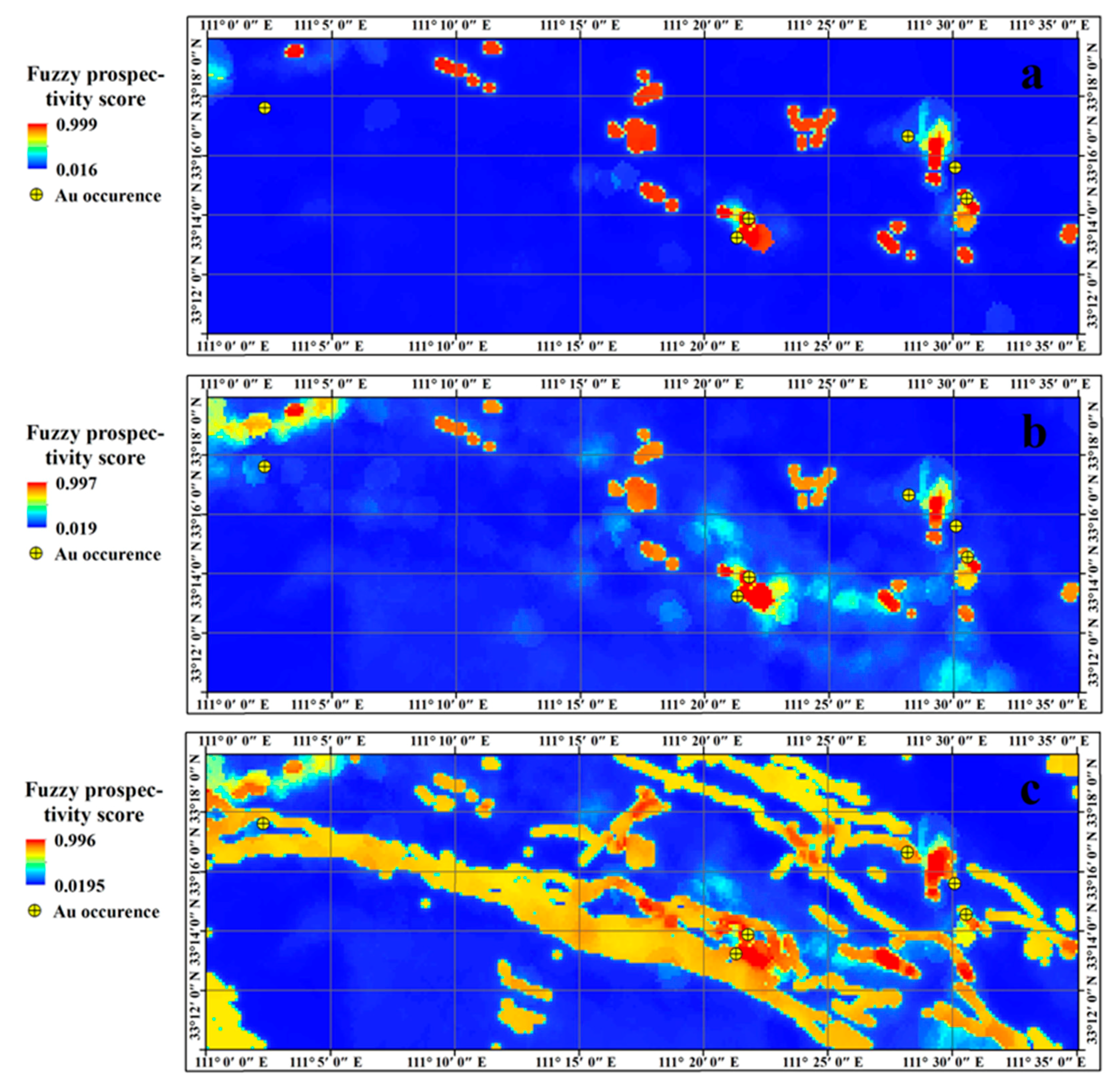
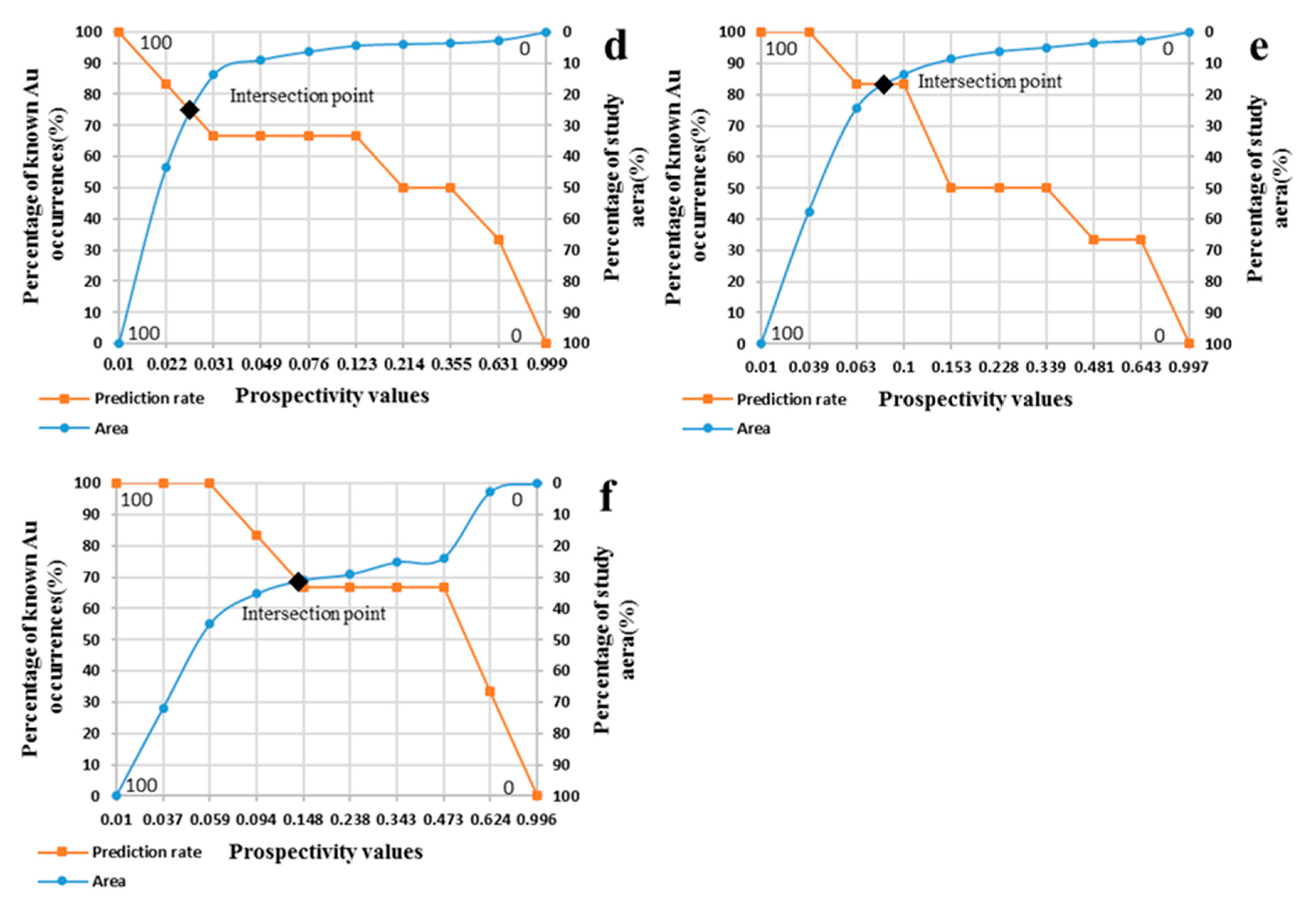


| First Main Phase | Second Main Phase | ||||||||
|---|---|---|---|---|---|---|---|---|---|
| First Stage | Second Stage | Third Stage | Fourth Stage | ||||||
| Element | F1 | F2 | Element | F1 | F2 | Element | F1 | Element | F2 |
| Au | −0.1 | 0.726 | Au | −0.07 | 0.719 | Cu | 0.698 | Au | 0.681 |
| Ag | 0.48 | 0.592 | As | 0.153 | 0.803 | Zn | 0.797 | As | 0.819 |
| As | 0.118 | 0.785 | Cu | 0.719 | −0.029 | Mo | 0.758 | Pb | 0.783 |
| Sb | 0.184 | 0.304 | Pb | 0.291 | 0.713 | Cd | 0.838 | ||
| Cu | 0.723 | −0.002 | Zn | 0.72 | 0.384 | ||||
| Pb | 0.257 | 0.685 | Mo | 0.771 | 0.072 | ||||
| Zn | 0.692 | 0.354 | Cd | 0.812 | 0.16 | ||||
| Mo | 0.761 | 0.1 | |||||||
| W | 0.266 | 0.235 | |||||||
| Cd | 0.803 | 0.195 | |||||||
| Evidential Layer | s | i |
|---|---|---|
| Structure | 0.3683 | 12.5090 |
| Heat source | 0.3680 | 12.5015 |
| Cu-Zn-Mo-Cd- | 0.0221 | 238.2672 |
| Au-As-Pb | 0.0253 | 193.4347 |
Publisher’s Note: MDPI stays neutral with regard to jurisdictional claims in published maps and institutional affiliations. |
© 2022 by the authors. Licensee MDPI, Basel, Switzerland. This article is an open access article distributed under the terms and conditions of the Creative Commons Attribution (CC BY) license (https://creativecommons.org/licenses/by/4.0/).
Share and Cite
Bai, H.; Cao, Y.; Zhang, H.; Wang, W.; Jiang, C.; Yang, Y. Applying Data-Driven-Based Logistic Function and Prediction-Area Plot to Map Mineral Prospectivity in the Qinling Orogenic Belt, Central China. Minerals 2022, 12, 1287. https://doi.org/10.3390/min12101287
Bai H, Cao Y, Zhang H, Wang W, Jiang C, Yang Y. Applying Data-Driven-Based Logistic Function and Prediction-Area Plot to Map Mineral Prospectivity in the Qinling Orogenic Belt, Central China. Minerals. 2022; 12(10):1287. https://doi.org/10.3390/min12101287
Chicago/Turabian StyleBai, Hongyang, Yuan Cao, Heng Zhang, Wenfeng Wang, Chaojun Jiang, and Yongguo Yang. 2022. "Applying Data-Driven-Based Logistic Function and Prediction-Area Plot to Map Mineral Prospectivity in the Qinling Orogenic Belt, Central China" Minerals 12, no. 10: 1287. https://doi.org/10.3390/min12101287
APA StyleBai, H., Cao, Y., Zhang, H., Wang, W., Jiang, C., & Yang, Y. (2022). Applying Data-Driven-Based Logistic Function and Prediction-Area Plot to Map Mineral Prospectivity in the Qinling Orogenic Belt, Central China. Minerals, 12(10), 1287. https://doi.org/10.3390/min12101287







